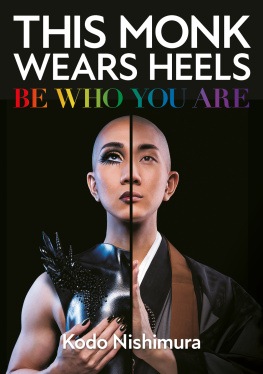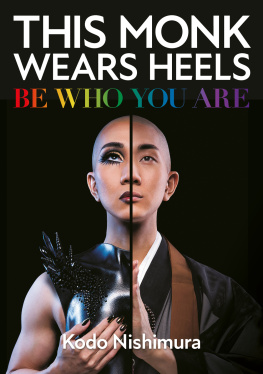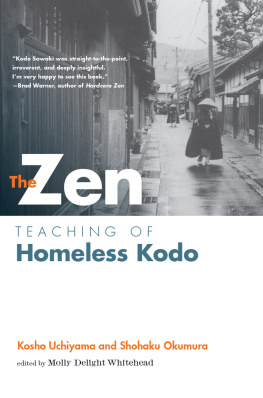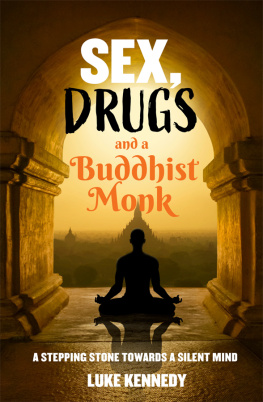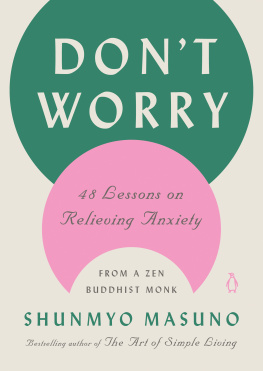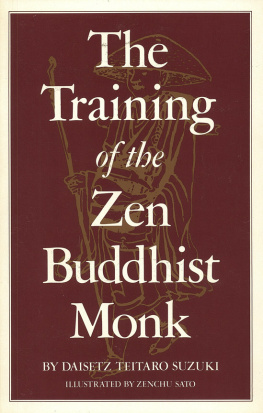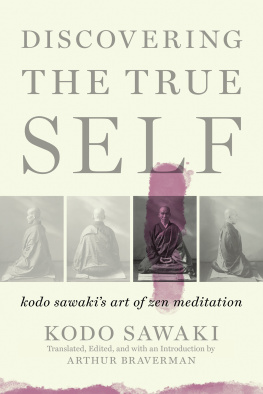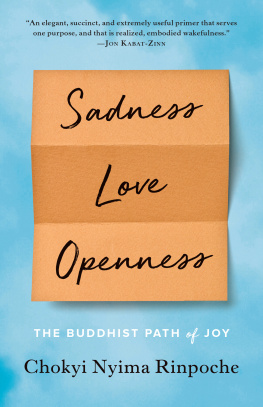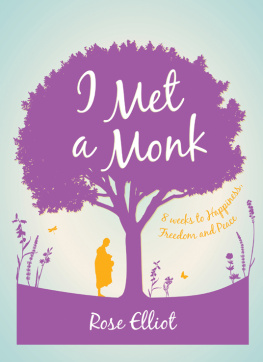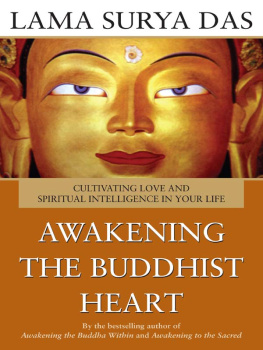

This Monk Wears Heels
Kodo Nishimura
First published in the UK and USA in 2022
by Watkins, an imprint of Watkins Media Limited
Unit 11, Shepperton House, 8393 Shepperton Road
London N1 3DF
Design and typography copyright Watkins Media Limited 2022
Text and illustrations copyright Kodo Nishimura 2022
Cover image copyright Seth Miranda 2022
The right of Kodo Nishimura to be identified as the Author of this text has been asserted in accordance with the Copyright, Designs and Patents Act of 1988.
All rights reserved. No part of this book may be reproduced in any form or by any electronic or mechanical means, including information storage and retrieval systems, without permission in writing from the publisher, except by a reviewer who may quote brief passages in a review.
Commissioning Editor: Fiona Robertson
Editor: Sue Lascelles
Editorial Assistant: Brittany Willis
Translator: Tony McNicol
Design concept: Josse Pickard
Designer: Kate Cromwell
Production: Uzma Taj
A CIP record for this book is available from the British Library
Printed in Bosnia and Herzegovina
ISBN: 978-1-78678-617-3 (Hardback)
ISBN: 978-1-78678-618-0 (eBook)
10 9 8 7 6 5 4 3 2 1
www.watkinspublishing.com
Praise for This Monk Wears Heels
My friend Kodo is so talented, brave, and graceful. They say to really know someone you must walk a mile in their shoes. Reading his story felt like I had popped on a pair of heels, and it was fabulous!
Carson Kressley, Emmy award-winning TV personality, style expert, fashion designer, and New York Times bestselling author
Due to the societal diktats, unconscious biaises, and stereotypes, the quest for our own identity is a long journey. Kodo-sans book is a generous, sincere, and moving testimonial that shows you the way to be in line with your own values and to find your inner diamond so that you dare to be who you are and who you want to be. This Monk Wears Heels is a warm invitation to live in harmony, love, and peace with oneself.
Sandrine Jolly, Brand President Worldwide, Shu Uemura
Reading This Monk Wears Heels makes you feel like you are in Kodos makeup chair. He heals your heart, and helps your beauty to shine with pride.
Riyo Mori, Miss Universe 2007
Kodos generosity and kindness shimmer across each delightful page of This Monk Wears Heels. His story will encourage every heart that longs for deeper, more meaningful connection. Kodo invites readers into the wisdom of Buddhism with such gentleness and skill a world-class example of offering traditional wisdom in fresh and gorgeously relevant new ways. Religious leaders who are trying to figure out how to invite emerging generations into new conversations take careful note this book belongs at the very top of your reading list.
Sue Phillips, co-founder of Sacred Design Lab, Unitarian Universalist minister, and an Innovation Fellow at Harvard Divinity School
Kodos inspiring and heartfelt book shines just as brightly as he does if you ever see him in person. Kodo takes us on his journey towards self-acceptance, healing, and transformation, demonstrating that sexuality, body-affirmation, and even difficult emotions like anger can all be integrated into a Buddhist path to finding true freedom. His story exudes warmth and honesty, giving us the confidence to look deeply at our own stories, to shine openly in our own rainbow palette of colors, especially when others do not want us to shine. Thank you Kodo for your beautiful offering to the world.
Elaine Lai, PhD Candidate in Religious Studies at Stanford University, co-president of the Buddhist Community at Stanford (BCAS)
a jewel of self-discovery, self-acceptance, and self-transformation that speaks to a universal spiritual journey. This Monk Wears Heels is a must-read for articulating how Buddhism can be reconceptualized for our time.
Hwansoo Kim, Religious Studies, Yale University
For anyone who has ever struggled to be honest with their heart.
Introduction

I am Kodo Nishimura, a Buddhist monk, makeup artist, and member of the LGBTQ+ community. I read sutrassacred scripturesas a monk, do makeup, put on heels, and wear sparkly earrings. From the age of 26, I have been proud to own my sexuality, but while I was growing up, I hid my true self from the people around me and lived my life thinking I was something to be ashamed of. I was afraid of being judged and humiliated. I felt guilty about being abnormal and concealed my true emotions.
When I was young, gay people were mostly shown in the Japanese media as being comical or perverted in some way. Many of the representations on TV were of men dressed up as women, being nasty divas and villains. There was nothing respectful or sophisticated about them. The portrayal of LGBTQ+ people as a whole was terrible. Fortunately, this image has been changing in Japanmany people have started talking about LGBTQ+ rights, and, since 2015, in many cities there have been growing numbers of same-sex partnerships.
All the same, because of the Japanese media, the culture, and the society I grew up with, I used to think that my sexuality was something to be ashamed of. However, when I traveled outside Japan, I met people who had overcome this sort of discrimination and who were living confidently. I learned that homosexuality has existed since long, long ago, and was recorded in ancient Roman and Greek times. I also learned the history of LGBTQ+ people, and that there was much homosexuality in ancient Japanese society too. I came to understand that there was nothing wrong with being LGBTQ+.
Nobody can say that it is wrong to be who you are.
My childhood home was the Tokyo temple where my father was a priest. My father was born into a farmers family. He was the second son, so he was not going to inherit the farm business. When he was five years old, he was taken to Tokyo to a distant relatives temple to be adopted by a couple who did not have children. Even though he was not allowed to choose his area of study, he graduated from university with a PhD in Buddhist studies and is now an emeritus professor.
Ever since I was young, people around me expected me to inherit the running of that temple one day. My friends and other people would really annoy me by asking if I was practicing reading sutras already, and if I would be shaving my head soon. I hated it.
Despite those expectations, my parents never suggested I should take over running the temple. Moreover, as they raised me, they accepted that I enjoyed princess role-play and drawing pictures. When I was little, I loved doing those things. Theres a comment from my teacher in the yearbook they made when we left kindergarten. It says that I often taught my classmates how to pretend to be Cinderella. At home, according to my mother, Id put on her miniskirt and twirl around and around. Look, Im a girl! Id say. My favorite thing was to dance to the song Bonjour from the Beauty and the Beast movie.
One day, when I was older and cleaning the house, I accidentally came across an old cassette tape of me singing when I was younger. I was improvising random songs and imitating different languages. Hearing that little me on the tape was a surprise. I was making jokes and I could just tell that I had lots of self-confidence. I had loved myself much more back then. When I was around five years old, I would look at myself in the mirror and sigh, I am so perfect; how can anybody be prettier than me? and I completely believed it. Where had that little me gone? The little me that expressed themselves so freely, with absolute confidence?
Next page
